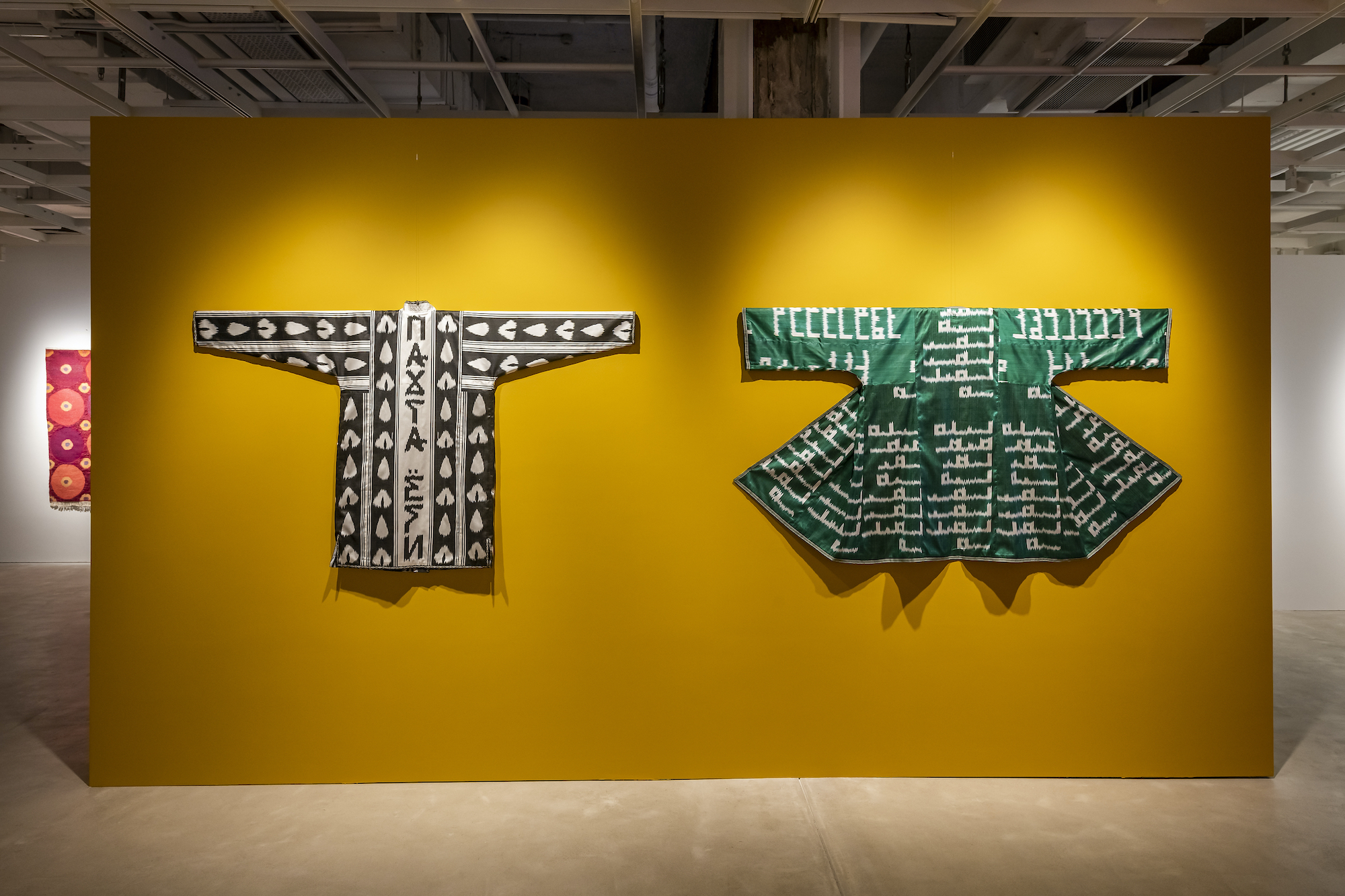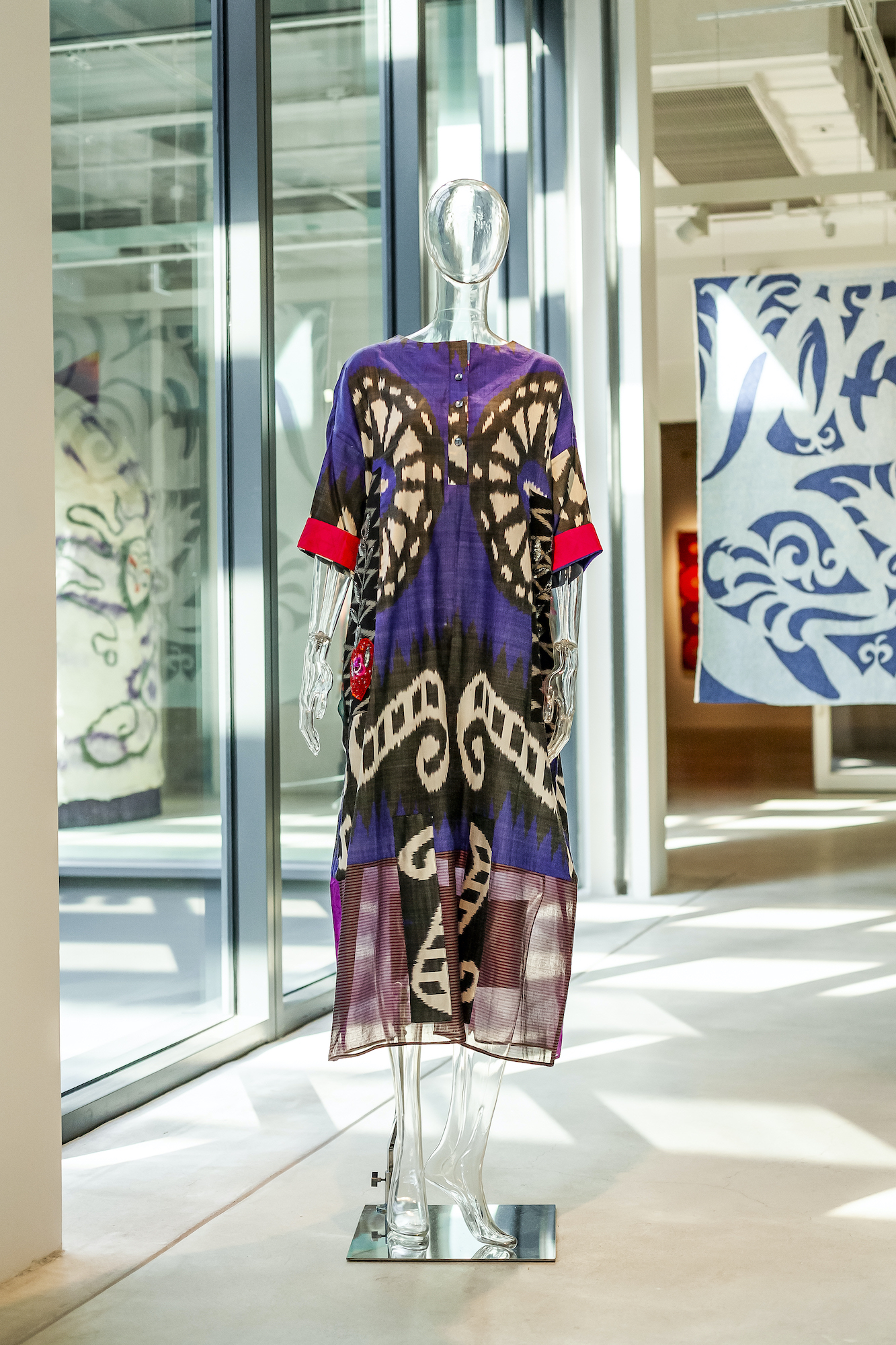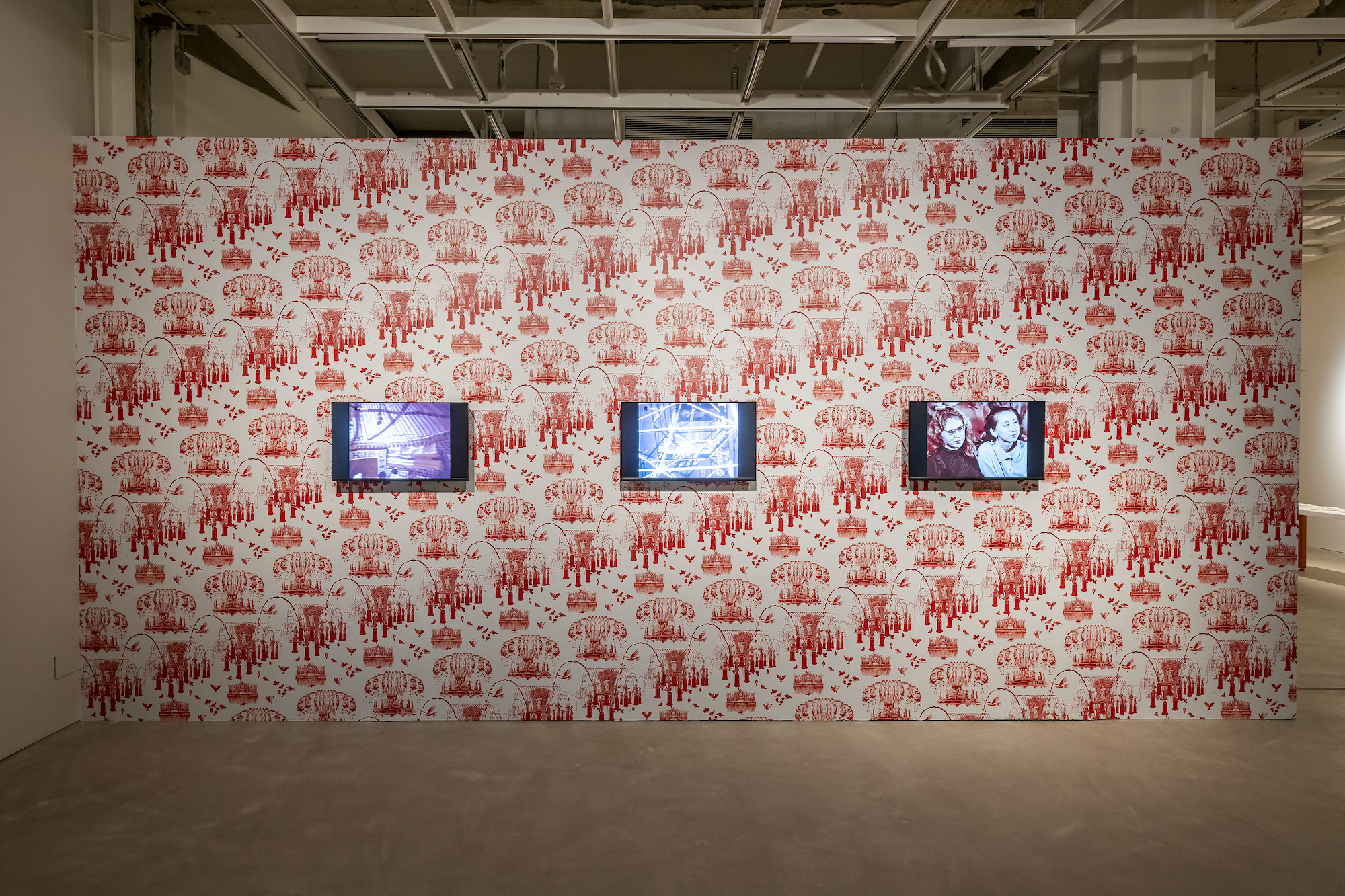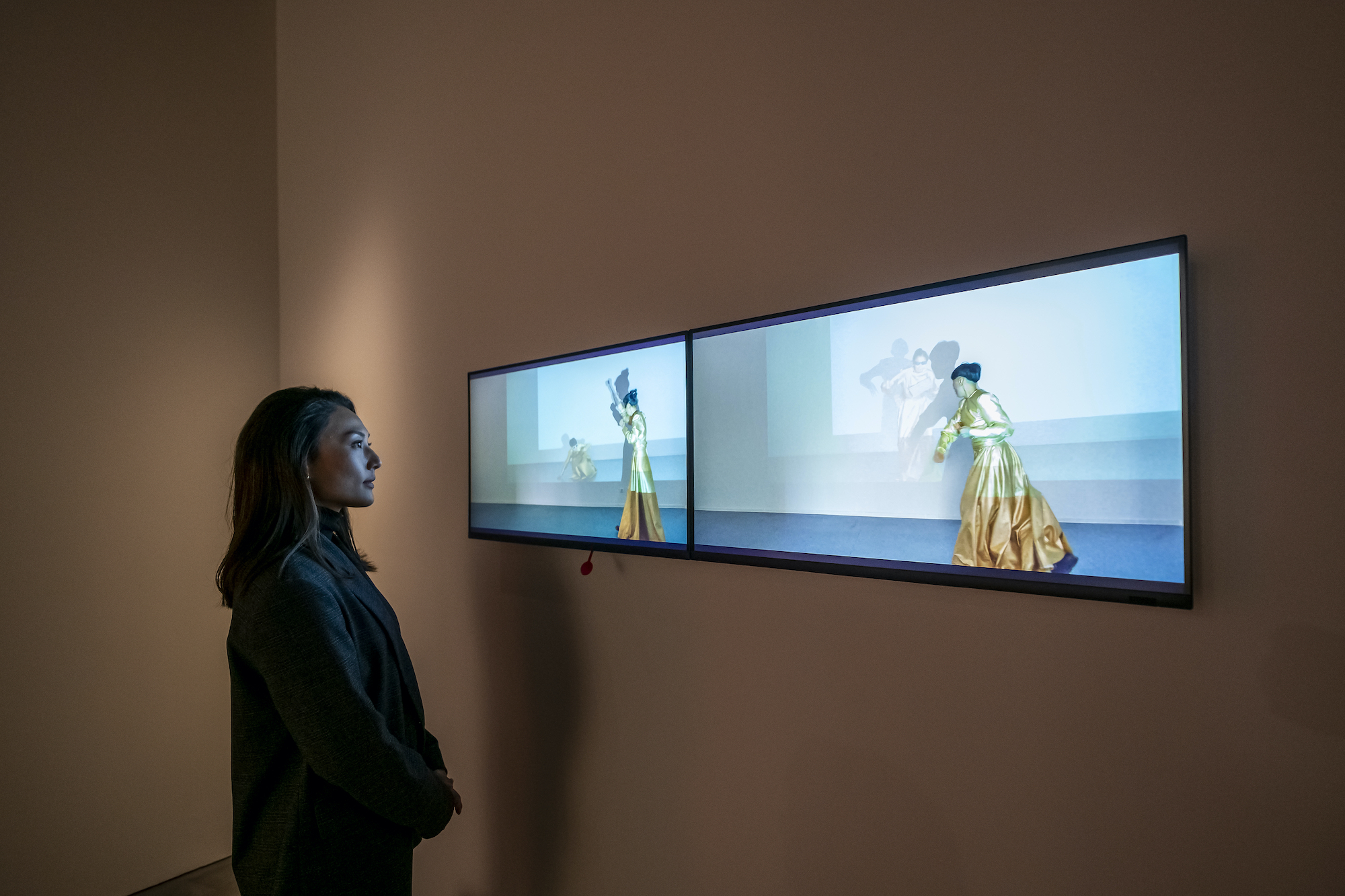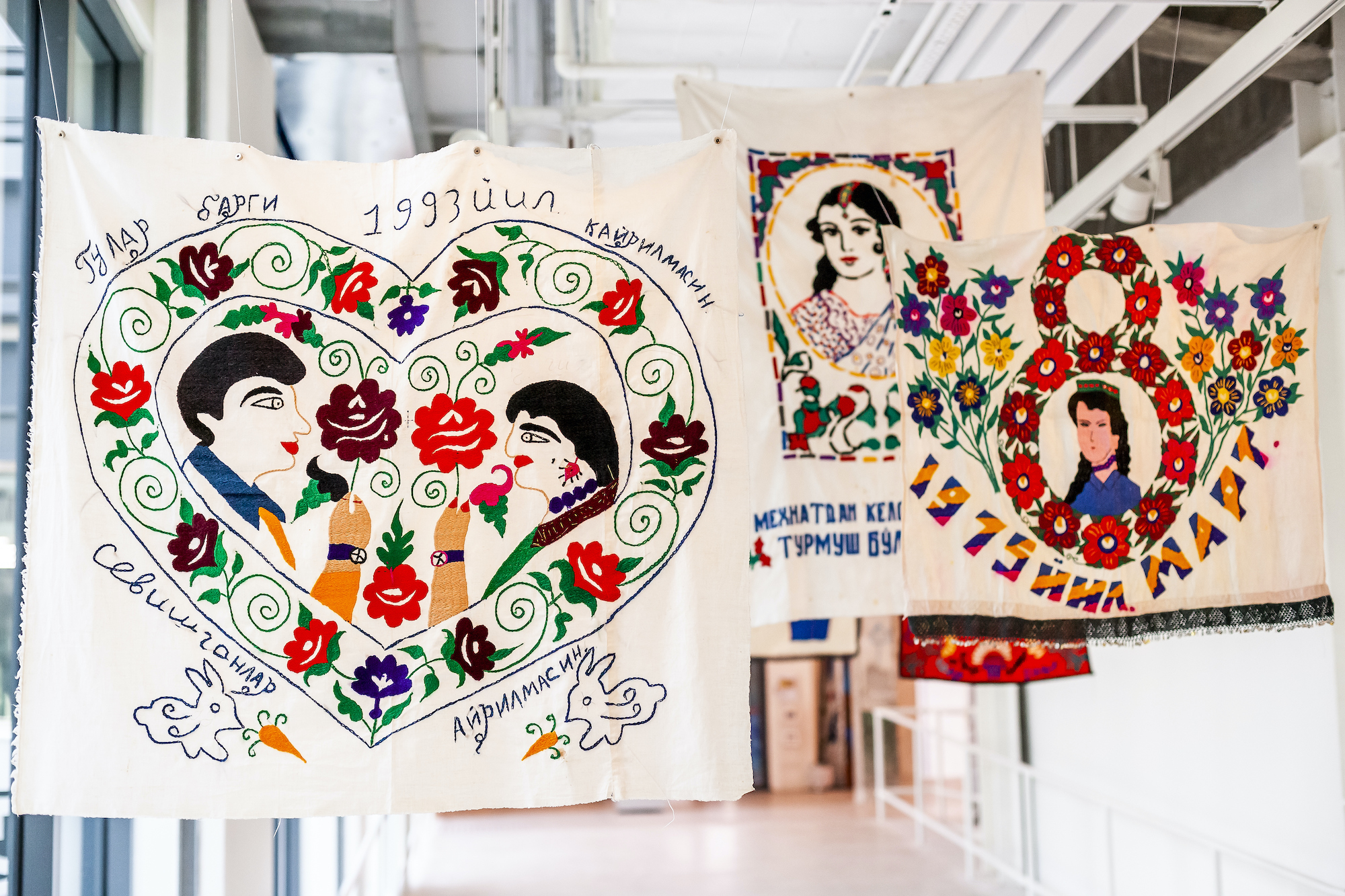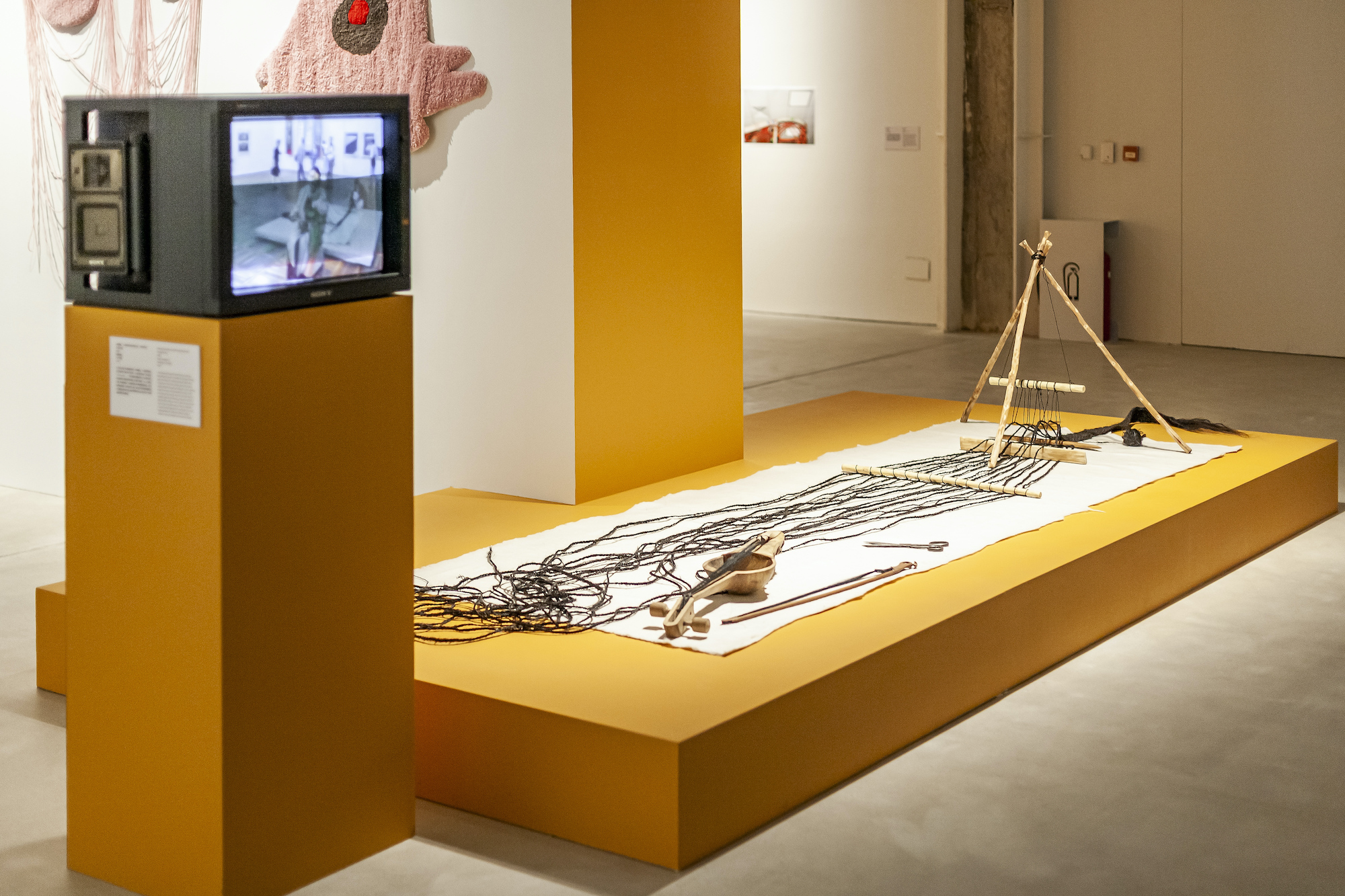Clouds, Power, and Ornament: Roving Central Asia
Clouds, Power and Ornament, installation view, 2023, [courtesy of the artists and CHAT (Centre for Heritage, Arts and Textile), Hong Kong]
Share:
Clouds, Power, and Ornament: Roving Central Asia is organized in two parts, starting with Clouds and Power, curated by Slavs and Tatars with You Mi. Positioned along the corridor leading to the main gallery are five hand-loomed tie-dye kaftans designed by Nazzy Belgari. Each one mixes forms of ikat—the Indonesian term for a resist-dye technique that produces blurred geometric patterns—to reflect the resulting fabric’s transregional quality. The blue floret–patterned columns on Nazzy 02 (2011), for instance, encompass handwoven tie-dyed vintage Uzbek ikat with Thai silk ikat that has been adorned with antique Indian Pachampali ikat.
Dilyara Kaipova & NoolOdin, National Uzbek Robe ‘Paxta Yogi’– Cottonseed Oil (from the Great Cotton Road Project series), 2022 [courtesy of the artists and CHAT (Centre for Heritage, Arts and Textile), Hong Kong]
Clouds and Power connects the mathematical precision of weaving threads into patterns with the “data loom” of the digital age—something that Dilyara Kaipova materializes in a commission for the show. Working with programmer NoolOdin, Kaipova produced a white pattern on a green woven kaftan from trinary code based upon the word paxta, Uzbek for cotton. This technique generated three types of lines that merged to create a calligraphic pattern resembling Kufic script, an Arabic writing system that appears throughout Uzbekistan’s mosques—pointing to the Arab influence on Central Asia, which includes the period from around 800 to 1200, known as a golden age of culture and commerce. Kaipova’s kaftan considers the waxing and waning influences of such histories across the region, which infuse its defining crafts and styles. The kaftan itself traverses a world of multiple times and places.
These complex, temporal relations fit neatly into the Persian term for ikat, abr-bandi, which refers to tying clouds into bands—particularly when comparing the digital “cloud,” by which data is available from any access point, with ikat’s transmission across geographical, cultural, and historical terrains. All of which sets the stage for Clouds and Power to explore Central Asia as a region bound as much by craft histories as it is by geopolitics.
Nazzy Beglari, Nazzy 005, 2019 [courtesy of the artist and CHAT (Centre for Heritage, Arts and Textile), Hong Kong]
Achievements of National Economy. Fountain of Friendship of Peoples of the USSR (Moscow, Russia) (2023), by Saule Dyussenbina, anchors this context to the 20th century. In this work, red prints of two monuments form a pattern over white wallpaper: The Friendship of Peoples Fountain, located in Moscow’s Exhibition of Achievements of National Economy complex—built for an exhibition that opened in 1939—and a cartouche featuring the Soviet Union’s state emblem on that complex’s Central Pavilion. The fountain incorporates 16 statues of maidens, each representing one of the USSR’s constituents, among them the Central Asian nations of Uzbekistan, Tajikistan, Turkmenistan, Kyrgyzstan, and Kazakhstan. On the wallpaper, the fountain’s blood-red watery plume appears like a mushroom cloud, as if to highlight the violent cohesion underpinning colonialist “unity.” Amplifying this violence is one of three video monitors installed over the wallpaper—each screening footage from Kazakh state archives—that shows the site where Soviet nuclear tests occurred between 1949 and 1989, with no regard for the Kazakh town of Semipalatinsk, located 150 kilometers to the west.
Saule Dyussenbina, Achievements of National Economy. Fountain of Friendship of Peoples of the USSR, 2023 [courtesy of the artist, and the Central State Archive of Film, Photo Documents, and Sound Recording of the Republic of Kazakhstan and CHAT (Centre for Heritage, Arts and Textile), Hong Kong]
The Man in the Fog (2022), by Askhat Akhmedyarov, draws this same timeline of colonialist violence into a neo-colonialist present, where the exploitation of a nation can take place within state borders and beyond them. Four blue textile banners bear bullet-shaped holes burned into their top layers with gunpowder to reveal red ornamental carpets beneath. One banner shows a hooded figure holding a black flag; another shows a truck turned upside down. Both images reference the 2022 “Bloody January” protests that erupted in Kazakhstan because of rising fuel prices, and which prompted a disproportionately violent state crackdown and the deployment of troops by the Russian-led Collective Security Treaty Organization.
Nearby, Aziz Hazara’s Tabkir (2022) expands this mapping of geopolitical violence. A single-channel video projected onto a large standing wall shows footage of Kabul’s night sky in the days leading up to the Taliban’s 2021 return to power in Afghanistan. These events were punctuated by the disastrous US withdrawal from the country after 20 years of occupation—a spectacle that evoked the Cold War and its afterlives, such as the Soviet Union’s 1979 Afghanistan invasion and occupation until 1989—only for the US to invade the country 12 years later. At times in Tabkir, night views of Kabul become a whirring blur; at others, the screen turns an overexposed white. Sounds from the city can be heard: disconcerting murmurs of life carrying on amid the chaos of upheaval, amplified by views of different neighborhoods, apartment lights on, as cars’ headlights flicker through the trees.
Bakhyt Bubikanova, Saga, 2022 [courtesy of the artist and CHAT (Centre for Heritage, Arts and Textile), Hong Kong]
Much like the blurred lines of ikat’s warp and weft, Tabkir amplifies the complexity of history’s long tail, as it flicks from one side to another. It’s a struggle that Bakhyt Bubikanova’s two-channel video installation Saga (2022) locates in the body within Suture: Reimagining Ornament, the second part of Clouds, Power, and Ornament: Roving Central Asia, curated by Alexandra Tsay. Filmed from behind, Bubikanova wears a gold dress as she tries to fight her video reflection projected onto the wall in front of her. The situation references the Kazakh syrmak carpet, which is made by cutting two layers of felt before the pieces are fused—what the artist sees as a material representation of the tensions and harmonies that define life as a process of mediation. To see these tensions otherwise, it seems, causes the condition that Saga diagrams. When complexity is treated as a series of binary oppositions, what follows are futile battles without end.
With that in mind, Suture: Reimagining Ornament resists the temptation to frame this exhibition about textile crafts solely by positing a macro-critique of geopolitics. Hung along a corridor leading to the exit are seven embroideries made in Uzbekistan to commemorate weddings, which Umida Akhmedova has collected since discovering one in a Tashkent flea market about a decade ago. Embroidered on white cloth, these folk compositions generally show the bride and groom with strong black lines and bright, primary colors, as with one image depicting a man and woman contained within the outline of a heart and framed by a bright red flower garland. Their visual uniformity circles back to the nature of craft as an intimate yet common diffusion of culture, knowledge, and history that bypasses borders while binding people together.
Umida Akhmedova, Naive Art of the Dowry, installation detail, 1970s-2000s, collected textile works, dimensions variable [courtesy of the artist and CHAT (Centre for Heritage, Arts and Textile), Hong Kong]
That commonality feeds into works by artists in Clouds and Power who immerse themselves in textile traditions to extend their reach into the future. Alibay Bapanov’s modernist wool tapestries turn mythical creatures from Turkic folklore into bold negative spaces on monochrome grounds—as with She-Wolf (2010), wherein a wolf’s off-white body snakes over the entirety of a red plane. Nazilya Nagimova’s triptych of herbal-dyed felt works—Metamorphosis, Four Skies, and Our Ways Will Never Cross (each 2022)—uses the ala-kyiz technique, which presses colored pieces of felt wool together to create patterns, to generate geometric abstractions magnified by folding the layers like origami. Madina Zholdybekova’s hanging pink carpets, Regular Star. Neutron Star. Black Hole (2021), celebrate the bodily transformations of motherhood. A trio of breasts, each pointing nipple down, hang in a line. The first is round, high above the ground, whereas the last one stretches way down. White fibers plunge from each tip. Each of these works resonates with Gulnara Kasmalieva and Muratbek Djumaliev’s Farewell Song, an installation that re-creates the aftermath of a 2001 performance at the Kyrgyz National Museum of Fine Arts in Bishkek, documented by a video screened on a TV monitor. Kasmalieva, wearing a Kyrgyz dressing gown, played the kyl-kyyak, a traditional string instrument, as craftswomen wove woollen threads into her hair with a hand-held spinning wheel to create a terme carpet. At the performance’s conclusion, Kasmalieva cut off her hair so that it could transform into something else—something rooted in tradition while also reaching beyond it. It’s a tension that defines art, craft, and bodies alike, as forms of live transmission.
Gulnara Kasmalieva & Muratbek Djumaliev, Farewell Song, 2001 [courtesy of the artist and CHAT (Centre for Heritage, Arts and Textile), Hong Kong]
Stephanie Bailey is an Art Papers contributing editor, global editor-at-large for Ocula Magazine, an editor for Art Basel Stories, and conversations curator and content advisor for Art Basel Hong Kong. Formerly the senior editor of Ibraaz, where she worked from 2012–2017, and director of the first BTEC-accredited foundation diploma in art and design in Greece from 2009-2012, Bailey has contributed to Artforum, Art Monthly, Art Review, dɪ’van: A Journal of Accounts, Spike, and Yishu: Journal of Contemporary Chinese Art, among others, and also edits for M+, the museum of visual culture in Hong Kong. She is currently working on a PhD at Birkbeck School of Law, University of London, exploring the historical and contemporary intersections between art and the pursuit of human rights.
